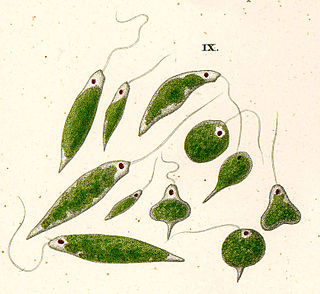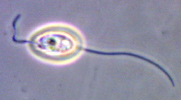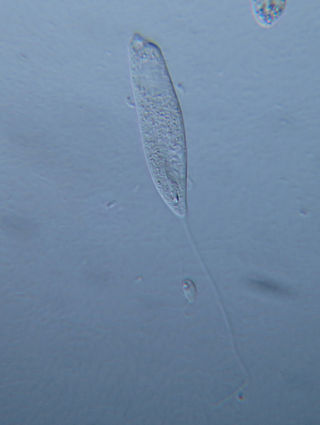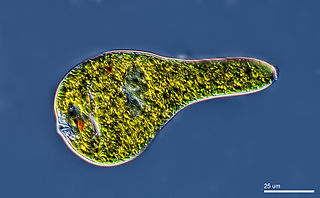
Euglenozoa are a large group of flagellate Discoba. They include a variety of common free-living species, as well as a few important parasites, some of which infect humans. Euglenozoa are represented by four major groups, i.e., Kinetoplastea, Diplonemea, Euglenida, and Symbiontida. Euglenozoa are unicellular, mostly around 15–40 μm (0.00059–0.00157 in) in size, although some euglenids get up to 500 μm (0.020 in) long.

Euglena is a genus of single cell flagellate eukaryotes. It is the best known and most widely studied member of the class Euglenoidea, a diverse group containing some 54 genera and at least 200 species. Species of Euglena are found in fresh water and salt water. They are often abundant in quiet inland waters where they may bloom in numbers sufficient to color the surface of ponds and ditches green (E. viridis) or red (E. sanguinea).

Euglenids or euglenoids are one of the best-known groups of flagellates. They are excavate eukaryotes of the phylum Euglenophyta, classified as class Euglenida or Euglenoidea. Euglenids are commonly found in freshwater, especially when it is rich in organic materials, with a few marine and endosymbiotic members. Many euglenids feed by phagocytosis, or strictly by diffusion. A monophyletic group known as Euglenophyceae have chloroplasts and produce their own food through photosynthesis. This group is known to contain the carbohydrate paramylon.

Trachelomonas is a genus of swimming, free-living euglenoids characterized by the presence of a shell-like covering called a lorica. Details of lorica structure determine the classification of distinct species in the genus. The lorica can exist in spherical, elliptical, cylindrical, and pyriform (pear-shaped) forms. The lorica surface can be smooth, punctuate or striate and range from hyaline, to yellow, or brown. These colors are due to the accumulation of ferric hydroxide and manganic oxide deposited with the mucilage and minerals that comprise the lorica. In Trachelomonas, the presence of a lorica obscures cytoplasmic details of the underlying cell. In each Trachelomonas cell, there is a gap at the apex of the lorica from which the flagellum protrudes. Thickening around this gap results in a rim-like or collar-like appearance. During asexual reproduction, the nucleus divides yielding two daughter cells one of which exits through the opening in the lorica. This new cell then synthesizes its own new lorica.

Chloromonas is a genus of green algae in the family Chlamydomonadaceae. It is closely related to the model green algae, Chlamydomonas, and traditionally has been distinguished mainly through the absence of a pyrenoid.
The Mesostigmatophyceae are a class of basal green algae found in freshwater. In a narrow circumscription, the class contains a single genus, Mesostigma. AlgaeBase then places the order within its circumscription of Charophyta. A clade containing Chlorokybus and Spirotaenia may either be added, or treated as a sister, with Chlorokybus placed in a separate class, Chlorokybophyceae. When broadly circumscribed, Mesostigmatophyceae may be placed as sister to all other green algae, or as sister to all Streptophyta.

Paulinella is a genus of at least eleven species including both freshwater and marine amoeboids. Like many members of euglyphids it is covered by rows of siliceous scales, and use filose pseudopods to crawl over the substrate of the benthic zone.

Euglenales is an order of flagellates in the phylum Euglenozoa. The family includes the most well-known euglenoid genus, Euglena, as well as other common genera like Phacus and Lepocinclis.

Euglenaceae is a family of flagellates in the phylum Euglenozoa. The family includes the most well-known euglenoid genus, Euglena.

Ochrophytes, also known as heterokontophytes or stramenochromes, are a group of algae. They are the photosynthetic stramenopiles, a group of eukaryotes, organisms with a cell nucleus, characterized by the presence of two unequal flagella, one of which has tripartite hairs called mastigonemes. In particular, they are characterized by photosynthetic organelles or plastids enclosed by four membranes, with membrane-bound compartments called thylakoids organized in piles of three, chlorophyll a and c as their photosynthetic pigments, and additional pigments such as β-carotene and xanthophylls. Ochrophytes are one of the most diverse lineages of eukaryotes, containing ecologically important algae such as brown algae and diatoms. They are classified either as phylum Ochrophyta or Heterokontophyta, or as subphylum Ochrophytina within phylum Gyrista. Their plastids are of red algal origin.

Phacus is a genus of unicellular excavates, of the phylum Euglenozoa, characterized by its flat, leaf-shaped structure, and rigid cytoskeleton known as a pellicle. These eukaryotes are mostly green in colour, and have a single flagellum that extends the length of their body. They are morphologically very flat, rigid, leaf-shaped, and contain many small discoid chloroplasts.
Euglenophycin is an ichthyotoxic compound isolated from Euglena sanguinea, a protist of the genus Euglena. It exhibits anticancer and herbicidal activity in vitro.

Euglena sanguinea is a species of the genus Euglena. The red colour is due to the presence of astaxanthin and the cells can be populous enough to colour water red. The pigment is used to protect the chloroplasts from light that is too intense, but as the light levels change the cells can take on a green colour as the red pigment is moved to the centre of the cells. Euglena sanguinea is known to make the potent icthyotoxin euglenophycin. Icthyotoxin euglenophycin is a toxin that is very similar in structure to solensopsin, a alkaloid that is found in fire ant venom. This is the only known species of euglenids that is able to form toxic blooms that cause tangible losses to fish farms.

Euglena viridis is a freshwater, single cell, mixotroph microalgae bearing a secondary chloroplast. Their chloroplast is bounded by three layers of membrane without a nucleomorph. Normally, it is 40–65 μm long, slightly bigger than other well-known Euglena species: Euglena gracilis.
Cryptoglena(/ˌkɹɪptoʊˈgliːnə/) is a genus of photosynthetic euglenids that was first described in 1831 by Christian Gottfried Ehrenberg. Today, its circumscription is controversial: Bicudo and Menezes consider twenty-one species as Cryptoglena, of which, nine are uncertain. Cryptoglena species are water-based, living in both freshwater and marine environments. They are biflagellated, with one internal flagellum and one external flagellum, which allows movement through environments as demonstrated by Kim and Shin in the species C. pigra. The cells of Cryptoglena resemble a coffee bean, as they have a groove that runs the length of the cell on one side and makes them U-shaped in cross section. They are ovoid in shape and are small, with the larger cells being on average 25 x 15 μm. After being first described in 1831, little work was done on the genus until the late 1970s and early 1980s, after the scanning electron microscope completed development and was implemented into laboratories. Work then proceeded with the developments of molecular biology, which allows for classifications based on DNA sequences. For Cryptoglena the main DNA used for classification are small subunit (SSU) and large subunit (LSU) rDNA.
Dinema, synonym Dinematomonas, is a genus of flagellated algae in the phylum Euglenozoa.

Ploeotia is a genus of heterotrophic flagellates belonging to the Euglenida, a diverse group of flagellated protists in the phylum Euglenozoa. Species of Ploeotia are composed of rigid cells exhibiting two flagella. The genus was described by Félix Dujardin in 1841.

The peranemids are a group of phagotrophic flagellates, single-celled eukaryotes or protists. They belong to the Euglenida, a diverse lineage of flagellates that contains the closely related euglenophyte algae. Like these algae, peranemids have flexible cells capable of deformation or metaboly, and have one or two flagella in the anterior region of the cell. They are classified as family Peranemidae (ICZN) or Peranemataceae (ICBN) within the monotypic order Peranemida (ICZN) or Peranematales (ICBN).

Spirocuta is a clade of euglenids, single-celled eukaryotes or protists belonging to the phylum Euglenozoa. They are distinguished from other euglenids by active deformation of their cell shape, a process called euglenid motion or metaboly. This is made possible by a high number of spirally arranged protein strips that run below their cell membrane and confer the cell with flexibility. These strips compose the helicoidal pellicle, a trait referenced by the alternative name Helicales.

Rapaza viridis is a species of single-celled algae within the Euglenophyceae. It is the only species within the genus Rapaza, family Rapazidae and order Rapazida. It was discovered in a tide pool in British Columbia along with its prey, Tetraselmis. It is the first example of a mixotrophic euglenid, and requires both photosynthesis and preying on microalgae to survive. Due to its unique mode of nutrition and phylogenetic position, it is considered an evolutionary step between phagotrophs and phototrophs.














